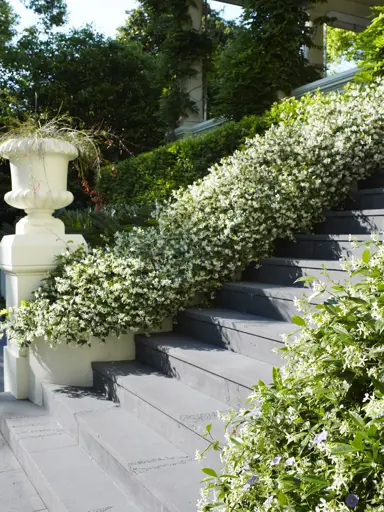
The Plant Company grows, sells, and ships Pear trees throughout NZ. We pride ourselves on producing high quality plants and seeing the joy from our customers when they receive them. We do hope you enjoy them and support this NZ business that is passionate about Pear trees.
The Conference pear tree is a popular variety due to its delicious fruit which have a yellow skin with a pink blush. These ripen in autumn and are...
The Comice pear tree (Pyrus communis Doyenne du Comice) is regarded as having the best flavour of all the pear varieties. It bears green skinned...
Pear William Bon Chretien is a popular variety due to its impressively flavoured fruit which ripen in late summer. The fruit have a green skin which...
Pear Belle De Jumet is grown for its sweet and juicy fruit which ripen in late summer. The golden fruit are held amidst the fresh, green foliage...
The Beurre Bosc Pear tree is grown for its flavoursome, brown skinned fruit which ripen in late summer. These are held amidst the fresh, green...
Pear Beurre Hardy (Pyrus communis) is a variety grown for its flavoursome, brown skinned fruit which ripen in late summer. The large fruit are held...
Pear Brown Beurre is grown for its flavoursome, brown skinned fruit which ripen in summer. These are held amidst the fresh, green foliage which...
The Concorde pear tree is a popular variety due to its delicious fruit which have a russeted, green skin. The fruit ripen in autumn and are held...
Why buy Sophora 'Goldies Mantle' from The Plant Company?
The Garden Belle pear is grown for its tasty fruit in late summer. The mildly russeted, green skinned fruit are sweet with a smooth texture. They are...
The Kieffer pear tree produces large, green-yellow fruit which have a coarse texture and juicy flesh. These ripen in autumn and are held amidst the...
The pear Louise Bon Jersey is grown for its tasty, medium sized fruit. The smooth, green skinned fruit are blushed with bronze-red and ripen in...
The Packhams Triumph pear is grown for its impressive and tasty, large sized fruit which ripen in late summer. The fruit have a green-yellow skin and...
The Red Bartlett pear tree is grown for its tasty fruit which ripen in summer and overall, aesthetic appeal. The fruit are borne dark purple and turn...
The Stark Crimson pear is grown for its interesting and tasty fruit which ripen in late summer. The fruit have a red skin, a finely textured flesh...
Pear Taylors Gold is a popular variety of pear due to its impressively flavoured fruit which ripen in autumn. The fruit have a golden skin with a...
Double grafted pear trees achieve higher yields due to better pollination and also extend the fruiting season. Taylors Gold and Beurre Bosc are both...
Sophora 'Goldies Mantle' is highly versatile in landscaping and works well as a specimen shrub, feature tree, or part of a mixed native planting. Its...
Double grafted pear trees achieve higher yields due to better pollination and also extend the fruiting season. Williams Bon Chretien and Winter...
The Winter Cole pear is grown for its impressively flavoured and textured fruit which ripen in late autumn. The rounded fruit have a russeted skin...
The Winter Nelis pear is a popular variety of pear due to its finely textured and flavoursome fruit which ripen in late autumn. These are held amidst...
The Pear Worden Seckel is grown for its interesting and tasty fruit which ripen in late summer. The fruit have a red-brown skin with white dots and a...
Growing Pears in your garden delivers a vast range of benefits:
From large Pear trees to small ones, we’ll help you find the right sized tree for your space. Our fruit trees have been selected to thrive in New Zealand’s climate. We stock only the highest quality plants, sourcing them from NZ’s leading nurseries. Each plant is packed and transported with extreme care, ensuring it arrives to you in the same condition it was in when it left the nursery. If you are wanting to buy Pear trees, shop with confidence from the best in the industry.
1. What is the best pear tree to buy?
The best pear tree to buy depends on your specific needs and preferences. However, some of the most popular and highly rated pear tree varieties include:
These are just a few of the many great pear tree varieties that are available. When choosing a pear tree, it is important to consider your climate, your desired ripening time, and your personal preferences.
2. What is the best pear variety NZ?
The best pear variety for New Zealand depends on your specific preferences and growing conditions. However, some of the most popular and well-suited pear varieties for New Zealand's climate include:
When selecting a pear variety for your New Zealand garden, consider factors like ripening time, flavor preference, suitability for fresh eating or baking, and compatibility with your local climate.
3. How do you grow a pear tree in New Zealand?
Growing a pear tree in New Zealand can be a rewarding experience, providing you with fresh, delicious fruit for years to come. Here's a guide to successfully growing pear trees:
Choosing a Planting Location:
Planting Your Pear Tree:
Pear Tree Care and Maintenance:
Harvesting and Enjoying Your Pears:
With proper care and attention, your pear tree will thrive in New Zealand's climate and provide you with an abundance of delicious, homegrown fruit for years to come.
4. Which pear tree grows the fastest?
The fastest-growing pear trees can grow up to 50-60 cm per year. The rate of growth depends on the growing conditions and how much fruit the tree is carrying. A heavily laiden tree will grow slower than one with fewer fruit.
5. What is the lifespan of a pear tree?
Pear trees (Pyrus communis) have a relatively long lifespan, with some varieties known to live for over 100 years. The average lifespan of a pear tree is between 35 and 45 years. However, the actual lifespan of a pear tree can vary depending on several factors, including:
Here are some tips for prolonging the lifespan of your pear tree:
With proper care, your pear tree can provide you with years of delicious fruit.
6. What is the easiest pear tree?
here are many pear trees that are easy to care for, but some of the most popular and easiest to grow include:
7. Do pears need a second tree?
Yes, most pear trees need a second tree for pollination and fruit production. Pear trees are self-incompatible, meaning they cannot pollinate themselves. They require pollen from another pear tree of a compatible variety to produce fruit.
The reason for this self-incompatibility is a genetic mechanism that prevents pear trees from pollinating themselves. This mechanism helps to ensure that pear trees produce offspring with a wider range of genetic diversity, which can help the species to adapt to changing environmental conditions.
To ensure pollination and fruit production, it is important to plant two or more pear trees of compatible varieties. The compatible varieties must have overlapping bloom times so that the pollen from one tree can reach the flowers of the other tree.
8. What is the most disease resistant pear tree?
Several pear tree varieties are known for their resistance to diseases, making them a good choice for home gardeners who want to minimize the use of pesticides. Here are some of the most disease-resistant pear trees:
These pear trees offer varying levels of disease resistance and may not be suitable for all climates or growing conditions.
9. What's the best tasting pear?
The best tasting pear is a matter of personal preference, as different people have different tastes. However, some of the most popular and highly rated pear varieties include:
These are just a few of the many delicious pear varieties that are available. When choosing a pear, it is important to consider your taste, your desired ripening time, and your growing conditions.
Whether you need assistance finding the plant you’re looking for or you simply want to know more about who we are and what we do, we invite you to get in touch with us today. A member of The Plant Company team will get back in touch as soon as possible.


